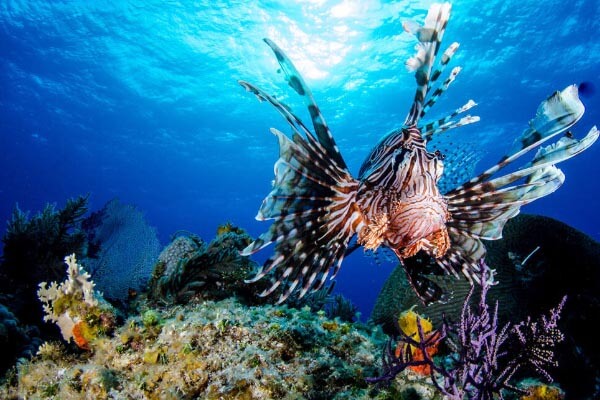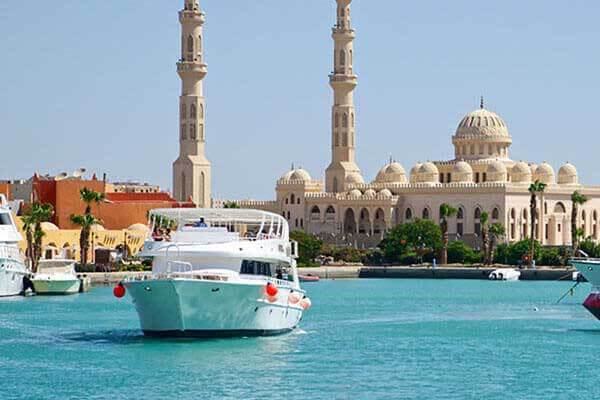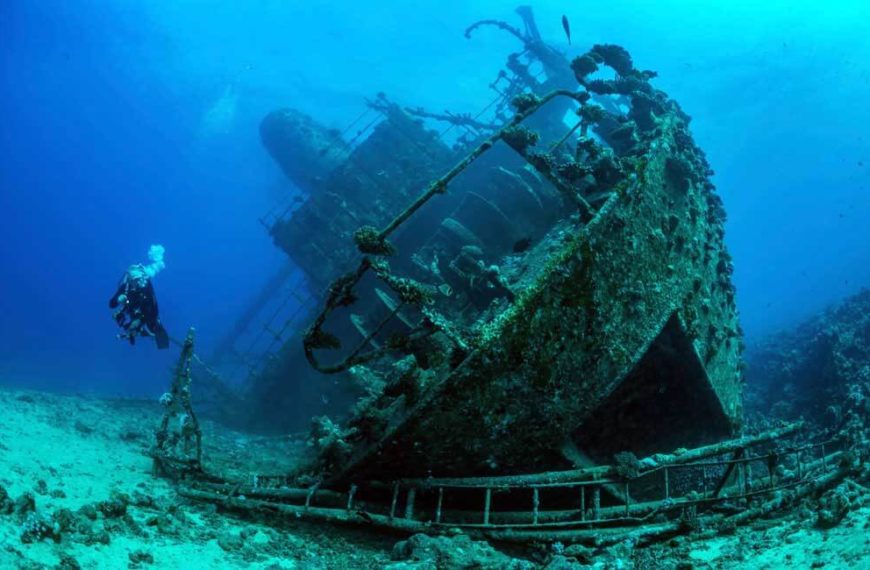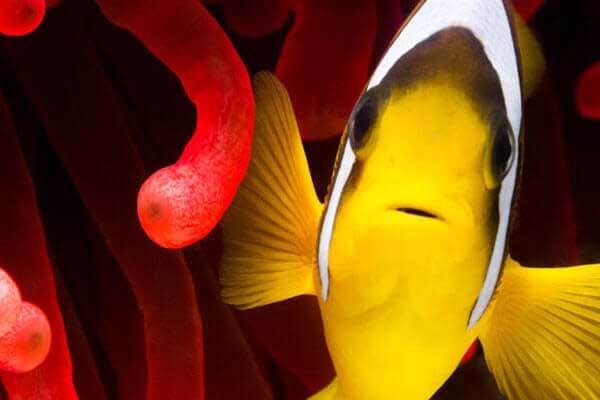
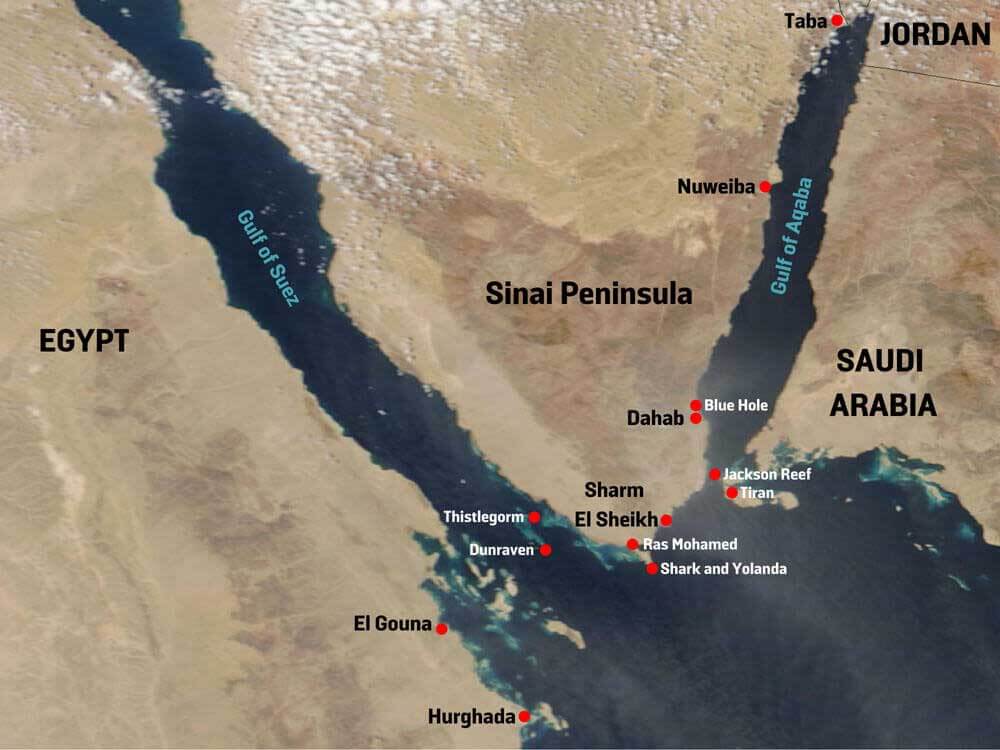
Sharm El Sheikh and Dahab
The popular resorts of Sharm El Sheikh and Dahab are situated towards the southern tip of the Sinai Peninsula at the northern end of the Red Sea, and are actually part of the Asian continent rather than Africa.
To the west, between Sinai and the mainland, lies the shallow Gulf of Suez, with an average depth of 40m and a maximum of 70, stretching 195 miles from the Straits of Gubal at its southern entrance, to the Suez Canal at its northernmost reach. To the east of Sinai lies the Gulf of Aqaba, stretching 100 miles between the Strait of Tiran in the south and the Israeli city of Eilat and the Jordanian port of Aqaba to the north. The Gulf of Aqaba is almost 2km deep in places and follows the deep sea volcanic trench of the East Africa Rift.
The two gulfs and the main body of the Red Sea meet at the southern tip of the Sinai Peninsula, in what is known today as Ras Mohammed National Park. The resulting deep upwellings and strong currents provide a constant source of nutrients for some of the Red Sea’s richest reefs. Scuba diving tourism from the early 1970s gave birth to the most popular Sinai resort of Sharm El Sheikh, with the town of Dahab, 80km to the north, providing a more laid-back alternative Red Sea experience. The towns of Taba, near the Israeli border, and Nuweiba, approximately half-way between Taba and Dahab, have also grown into tourist destinations, although not as busy, and far less popular with scuba diving vacationers.
SHARM EL SHEIKH
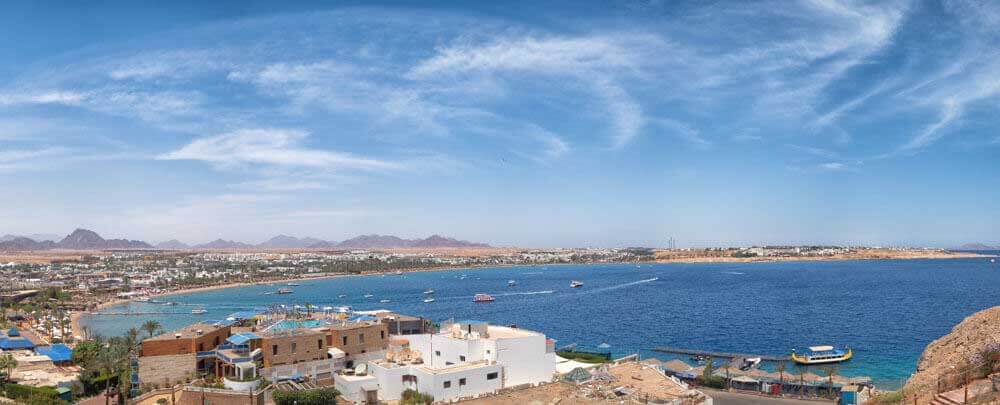
Probably the best-known diving destination for Europeans, Sharm began life in the early 1970s during the period of Israeli occupation after the six-day war of 1967. The resort as we know it today was little more than a Bedouin fishing camp, with the large bays of Na’ama Bay and Sharm El Maya (now known as Travco harbour) providing shelter from the often inclement seas. The town slowly grew as a mostly Israeli tourist destination, until the Sinai Peninsula was handed back to Egypt in 1982 as part of the settlement negotiated in the 1978 Camp David Peace Accords. Sharm was marked for development as a tourist resort, rapidly growing into a modern city of hotels we know today. Development was further expanded to include the region of Nabq at Sharm’s northern limits, and El Hadaba to the south. The focal point of the resort remains Na’ama Bay, the location of the biggest-name dive centres, as well as a range of nightclubs, bars and restaurants – and an excellent house reef.
Diving
The diving is split into three main areas: The national park of Ras Mohammed, the island reefs of Tiran and the ‘local’ dive sites, a general term given to the dive sites that lie along the shore. The local dive sites are generally less affected by strong currents, have shallow areas interspersed with sandy patches, and are suitable for entry-level dive training. Some of the reefs have been hit by the amount of coastal development, but by and large remain vibrant with plenty to see. Some experience (20 dives and an AOW or equivalent certification) is required to visit Tiran and Ras Mohamed, partly due to the extremely strong currents that can be present (especially in Tiran), and also to prevent damage to the reef from inexperienced mistakes.
Some shore-based diving is available for but is often limited to whichever hotel fronts that part of the beach. The house reefs of Na’ama Bay, which is fronted by a number of hotels, are roped off and protected making for easy diving and entry-level training, likewise at Shark’s Bay further up the coast. Some dive centres offer a fantastic overnight camping trip and shore diving experience in the National Park of Ras Mohamed.
Most of the diving is by day boat from either Na’ama Bay or the larger jetty of Travco. Journey time to Ras Mohamed and Tiran is between 1 – 1.5 hours and the boats stay out all day, with lunch available on board. Boat trips to the local dive sites often return to the jetty during the surface interval, great for folks who have other activities planned. Sea conditions along the coast are usually fairly mild, but further out to sea they can be uncomfortably rough, especially during the voyage to the exposed reefs of Tiran.
Must See Dive Site: Shark and Yolanda

Sharm’s most iconic reef is the twin pinnacles of Shark and Yolanda, situated on the edge of a shallow saddle filled with lush coral gardens. The almost perfectly cylindrical Shark Reef drops vertically to the sea bed 800m below, and the front of the reef, where the prevailing current splits to either side, is home to a staggering collection of golden anthias. In the summertime, huge schools of Bohar snapper gather in the split, and a school of chevron barracuda often circulating below. The shallow saddle is home to a resident population of giant trevallies, with giant morays, green and hawksbill turtles, Napoleon wrasse and a school of batfish commonly sighted.

The second, wider reef of Yolanda is named for the ship that foundered and later sank here. The vessel itself is long gone, but her cargo of bathroom supplies including bathtubs, sinks, and the famous toilets, remains in situ – along with the captain’s BMW. Currents can be strong and multi-directional here but easy to manage if you stay close to the reef. The best guides will check the current and dive the site in reverse when necessary, and if the current is mild, jumping at the nearby Anemone City and drifting through the blue to Shark is a spectacular start to the dive.
Must See Dive Site: Jackson Reef

The northernmost of the island reefs in the Strait of Tiran, Jackson has two stunning coral gardens at either end, reaching from the surface and descending through a relatively shallow slope into the depths. In-between is a sheer wall which plateaus out at around 60m, filled with an astounding array of soft coral. Turtles are almost always present and the gardens are an easy place to spot blue spotted rays and stonefish. an almost permanent school of fusiliers is present just off the reef, and bigger fish sometimes pass by out in the blue.
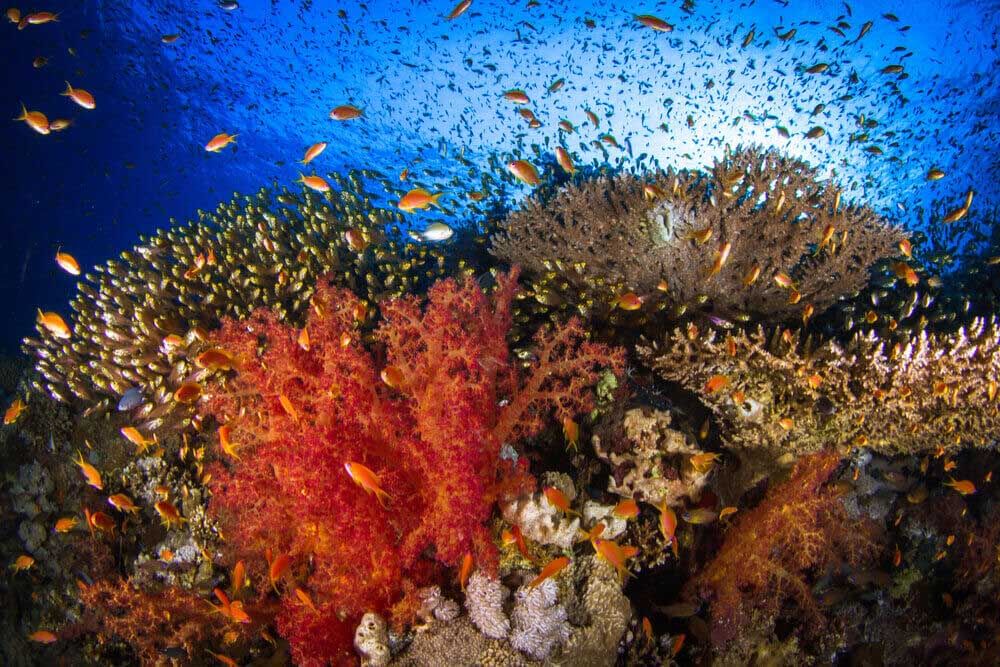
Currents can be very strong here and it’s essential that divers stay behind their guide and look to shelter in the coral gardens when necessary. While the ‘inside’ of the reef is sheltered from the wind and waves, getting pushed around the corner in heavy seas makes for a difficult and dangerous pickup by the larger boats. When the outside is flat, divers often jump for a blue-water dive in search of the resident population of scalloped hammerheads. Look out for playful pods of spinner dolphins on the return journey, and the Risso’s dolphins that make their home between Jackson and Laguna, Tiran island’s fringing reef.
Notable Wrecks

By far the most famous wreck dive from Sharm is the SS Thistlegorm, a British freighter sunk in 1941 carrying supplies of trucks, motorcycles and armaments for the British army. The 1876 wreck of the SS Dunraven, which lies upside down at around 26m rising to around 12m, is well worth a visit. Less regularly dived is the Red Sea’s biggest wreck, the Million Hope, which sank in 1996 just off the Nabq shore and, bizarrely, directly on top of the 1970 wreck of the Hey Daroma, almost completely lost beneath the Million Hope’s massive hull.
DAHAB

Approximately 80km north of Sharm is the laid-back town of Dahab. Unlike Sharm, Dahab was home to a previous settlement of Bedouin fishermen, and originally grew in popularity as a backpacking destination, the atmosphere of which it retains to this day. At the centre of Dahab is Masbat Bay, with the residential area of Asalah to the north, and Mashraba, with some larger hotels, to the south – all situated along approximately 3km of shoreline. The more modern development of Medina, with a host of hotels and resorts, has grown up a few kilometres to the south and west of the older part of town. It is the backpacker-esque central part of Masbat, however, that many visitors find most attractive. The beach-front is lined with casual bars and cafe restaurants, with a collection of small dive centres, shops and hostels on the other side of the road. The famous Bedouin hospitality is ever-present, and visitors will find that there is much less in the way of harassment from street-vendors as they stroll along the promenade.
The Diving
Most of the diving in Dahab is from shore, with some of the larger centres operating boats to explore the less-accessible reefs of sites such as Gabr El Bint. As a result, diving days are often shorter than they would be on the boats from Sharm, leaving more time for other activities, or less time away from non-diving family members. Some sites, such as the Blue Hole, are a little way off the beaten track and take a bit of off-roading to reach, and although the diving is year-round, the ever-present wind (which also makes Dahab so popular with wind- and kite-surfers), makes the water temperature, and changing out of wet dive gear in the open air, rather chilly. The coral reefs are perhaps not quite as rich as those found in Sharm, but there is still plenty to see. The never-ending fields of seagrass around the Lighthouse are well worth a dive to spot the plentiful seahorses and pipefish. There is little in the way of current at any of the dive sites, most of which are suitable for novices as well as the more experienced. Together with the laid-back atmosphere and easy shore diving, visitors will find themselves more than adequately compensated for anything they might be missing further south.
Must See Dive Site: The Blue Hole
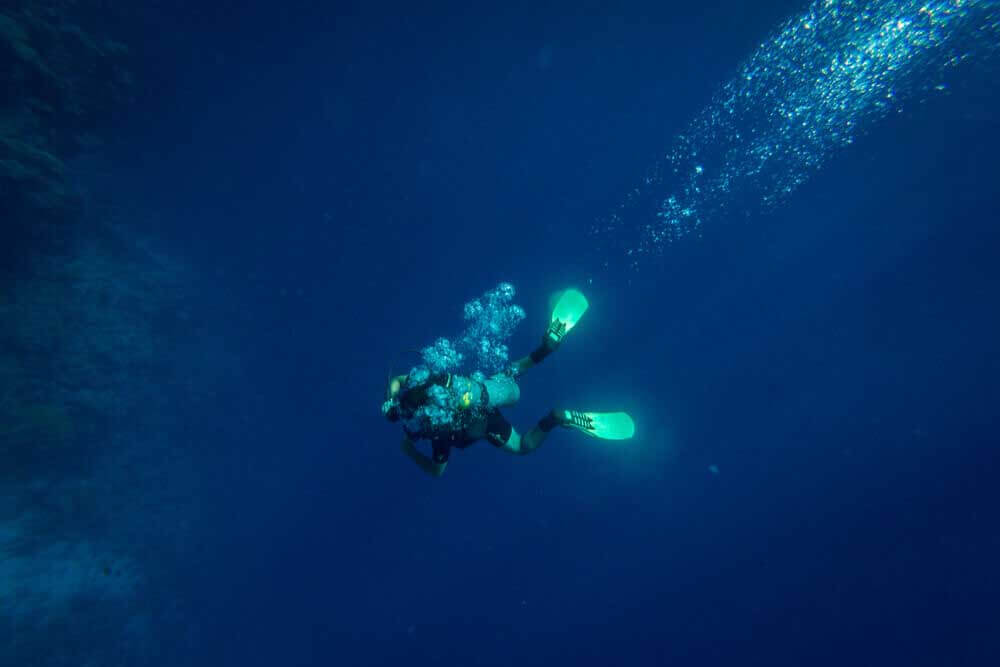
The best way to dive the Blue Hole is to take a short walk along the foot of the cliffs and enter the water through ‘El Bells’, a narrow chimney in the reef so-named for the shape of its openings, although veteran Dahab divers will say it’s because of the noise people make as they bang their tanks during descent. You can choose to descend outside the Bells if you prefer, before turning right and diving the spectacular and steep wall that leads towards the entrance to the Blue Hole. Some of the largest elephant-ear coral can be found lining the outside, with plenty of the usual Red Sea flora and fauna sheltering in the overhangs and cracks. After about 45 minutes, divers reach a vibrant 7m-deep coral garden that leads into the Blue Hole, where they can enjoy swimming out across the immense, 100m deep sinkhole, or hug the wall for a circuit before safety stopping near the exit. The Blue Hole is a perfect training environment for tech divers and freedivers, and watching the freedivers practice can be a particular highlight towards the end of the dive – especially when they disappear for longer than it takes to make your safety stop!
Must See Dive Site: Canyon

A small and shallow lagoon, often used as a training area, leads out over a narrow ledge onto a wide and sandy plateau interspersed with small pinnacles and coral blocks. The site is a great place to stop and admire the life that thrives within each block, especially the schools of glassfish and the smaller coral wrasse that bloom like fireworks from the coral heads and then retreat inside as you get closer. Stonefish are easy to spot, and the canyon is a great place to find Red Sea walkmen, a species of lionfish than walks along the sand using its fins for locomotion. The canyon is rather a lot smaller than its name implies, but it’s worth heading into the open crack in the reef to enjoy the way that light from the blue Egyptian sky plays through the opening. The air that divers exhale filters through cracks in the canyon walls and is released through the sand as a curtain of bubbles surrounding the opening. There’s always a chance of seeing eagle rays and other larger species cruising along the drop-off
Notable Wrecks
Trips to the Thistlegorm and Dunraven are available from some of the dive centres, however it is a very early morning start and a late return.


